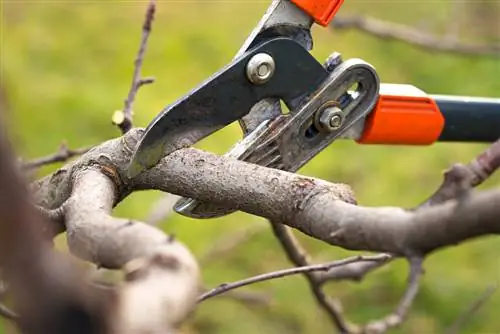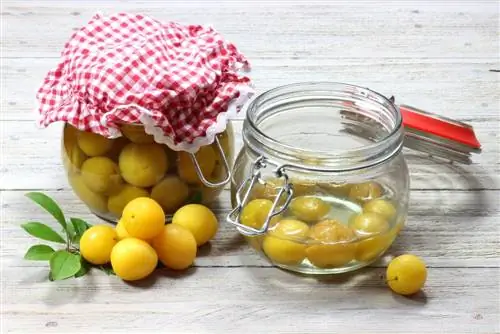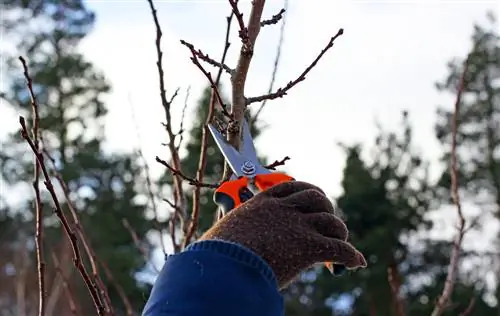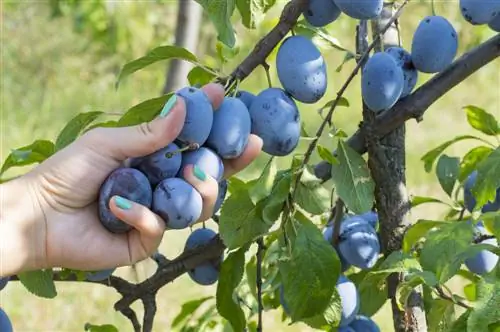- Author admin [email protected].
- Public 2023-12-16 16:46.
- Last modified 2025-01-23 11:21.
Mirabelle trees grow very quickly and spread quickly. In order for them to develop well and produce numerous ripe fruits, you need the right cut at the right time. There are six ways to successfully cut the mirabelle plum:
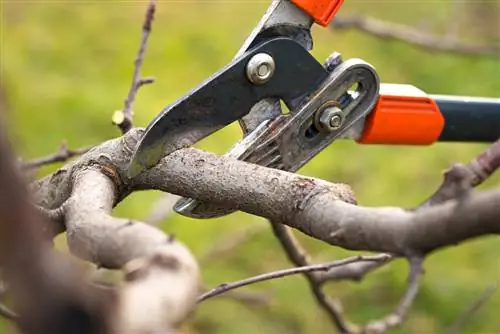
Which types of pruning are important for the mirabelle plum tree?
Cutting mirabelle is successful with topiary pruning, training pruning, fruit wood pruning, maintenance pruning and rejuvenation pruning. By pruning at the right time, the tree develops optimally and produces numerous ripe fruits.
- Topiary
- Fruit woodcut
- Educational Cut
- Conservation cut
- Rejuvenation cut
The first topiary
It is preferable to have the topiary done at the tree nursery right from the start. The professionals know how to cut the mirabelle plums appropriately for optimal shaping on bare-rooted trees. If you still want to take action yourself, pay attention to the relationship between crown and root: shorten the root a little and thin out the crown by a third.
The basic approach to parenting
With the training cut shortly after planting and the first flowering, you can lay a stable foundation for your young mirabelle tree. The aim is to create a sensible division into the main trunk, scaffolding branches and fruiting branches. How to proceed:
Step by step to the educational cut
- Short the leading branches by a third.
- It is best to have the tips of the upper shoots positioned just below the top of the trunk.
- The last eye (bud at the bottom) preferably faces outwards.
- Remove excess shoots completely.
- You should also remove water shoots that grow steeply upwards. Because these cost the plant a lot of energy.
- Finally, remove all shoots that grow below the main branches.
- Leave the main shoot untouched.
The Occasional Fruit Woodcut
For a tree that is growing strongly but hardly produces any buds, it is advisable to cut the fruit. It is important to prune a strong mirabelle tree only moderately, while a weak tree should be pruned more heavily. Over time, the fruit wood sinks significantly. Hanging areas are then no longer supplied with enough nutrients. New shoots thus take on the function of fruit branches. These form at the apex of the original fruit branch. Cut the old branch back to the new shoot.
The regular maintenance cut
Regular maintenance pruning is particularly important for a productive harvest. It ensures that the crown does not become too dense due to aging branches and shoots. Otherwise, flowers and fruits could not absorb enough light. After the five-year training phase of the mirabelle, you begin with the maintenance pruning: Every year after the flowering period between April and May is the optimal time for the maintenance pruning of the mirabelle. Carefully cut out all dead shoots, including those growing inwards. Intersecting components must also give way. In addition, a mirabelle plum tree forms numerous water shoots that rise steeply upwards, which rob it of energy. Remove these shoots comprehensively as well. Don't forget about those shoots sprouting from the roots. You should also cut this competition for the fruit-bearing areas back to the trunk.
Altershilfe rejuvenation cut
Very old trees with hardly any new shoots could be given new life by rejuvenating them. To do this, use your eye to cut out anything that disrupts a harmonious image. Remove water shoots, old branches and those that protrude into the crown. The cut can reach right into the old wood.
For regular budding, always cut the entire crown, not just individual areas. Winter pruning, which is sometimes still recommended, is not advisable. Rather, it increases the risk of disease or damage to the tree.

